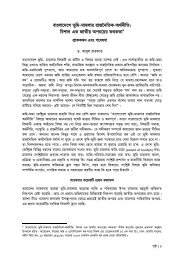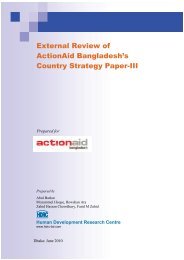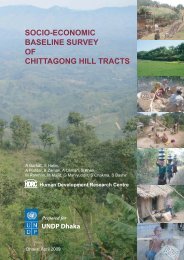08. Costing Essential Services Package An Issue Paper
08. Costing Essential Services Package An Issue Paper
08. Costing Essential Services Package An Issue Paper
You also want an ePaper? Increase the reach of your titles
YUMPU automatically turns print PDFs into web optimized ePapers that Google loves.
<strong>Costing</strong> <strong>Essential</strong> <strong>Services</strong> <strong>Package</strong>: <strong>An</strong> <strong>Issue</strong> <strong>Paper</strong> 12<br />
5.1. <strong>Costing</strong> ESP: PPC’s exercise<br />
The basic purpose of PPC’s costing exercise was to arrive at an estimate of the resource<br />
requirements as well as to facilitate planning exercises for HPSP. The PPC undertook the<br />
costing analysis as a basic requirement for pre-appraisal and appraisal of the HPSP. The<br />
relevant chapters of the HPSP document delineate the costs of sectoral activities and<br />
expenditure plan, the amount of resources to be available for the sector, and the possible<br />
economic, fiscal and distributional impacts of the HPSP activities, expenditure by logframe<br />
activities, and cost estimates by commodities. 4> Since, our purpose of review is limited to<br />
costing ESP, the emphasis will accordingly be limited to this domain.<br />
According to the PPC’s methodology, expenditures for ESP service delivery and<br />
expenditures for ESP are not the same 5> . As shown in Figure 9, expenditures for ESP<br />
(69.89% of HPSPs first year costs) is 10 percentage points higher than the expenditure for ESP<br />
service delivery (59.54% of HPSPs first year costs). Expenditure for ESP equals to expenditure<br />
for ESP service delivery (which is the first out of eight components of HPSP, Figure 2) plus<br />
expenditures on account of ESP of non-ESP components (7 out of 8 components of HPSP).<br />
The relative shares of non-ESP Components’ ESP part as shown in Figure 10 range between<br />
0% (for the component – Policy, Regulation, NGO and Private Sector) and 40% (for the<br />
component – Integrated Support <strong>Services</strong>). Whether these relative shares are notional or<br />
based on rigorous cost analyses will be discussed later on.<br />
<strong>Costing</strong> (expenditure) of<br />
ESP Service Delivery<br />
Figure 9:<br />
HPSP <strong>Costing</strong> (Year 1)<br />
(59.54% of HPSP) (10.35% of HPSP)<br />
Expenditures for ESP (69.89% of HPSP)<br />
<strong>Costing</strong> of other than ESP services<br />
delivery components of HPSP<br />
(7 components in Figure 2)<br />
4><br />
For details, see HPSP, PIP-Part 1, Chapter 5 (GoB 1998a: 69-107); and HPSP, PIP-Part II, <strong>An</strong>nexure<br />
3 and 15 (GoB 1998b: 59-178, 405-523).<br />
5> HPSP document conceptualizes this as follows “the expenditure for ESP constitutes a genus, of which<br />
expenditure for ESP delivery is the major species” (GoB 1998a: 71).






